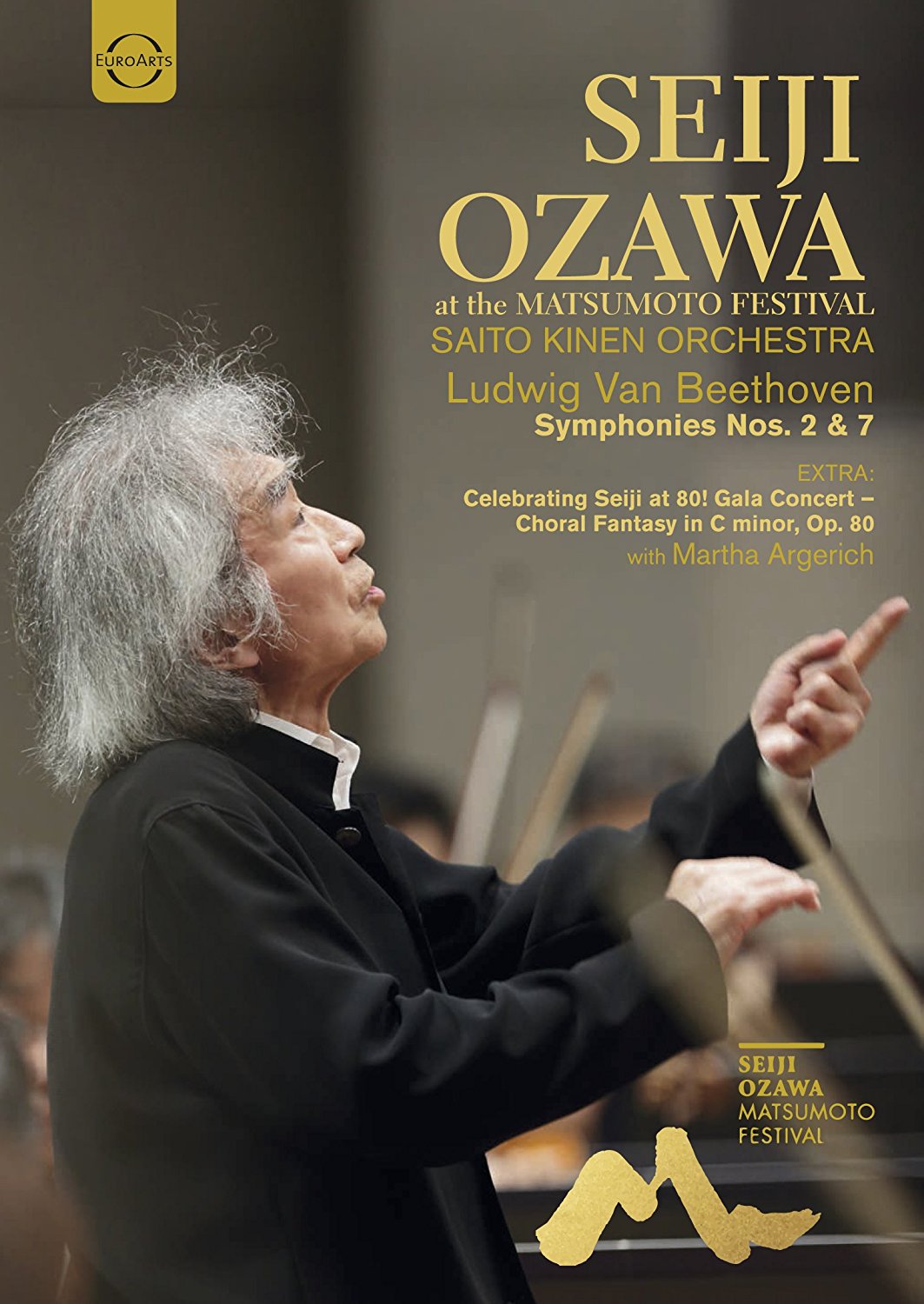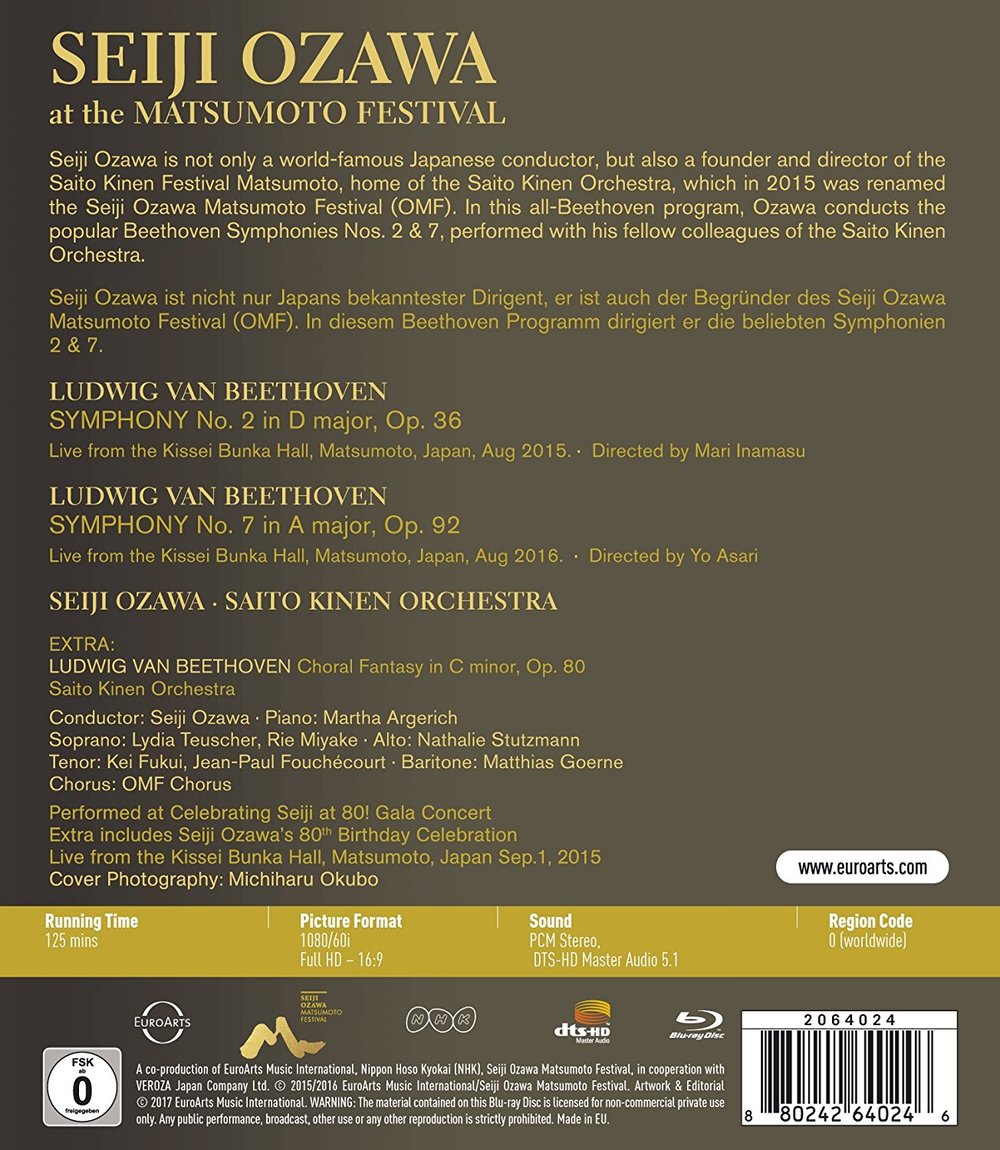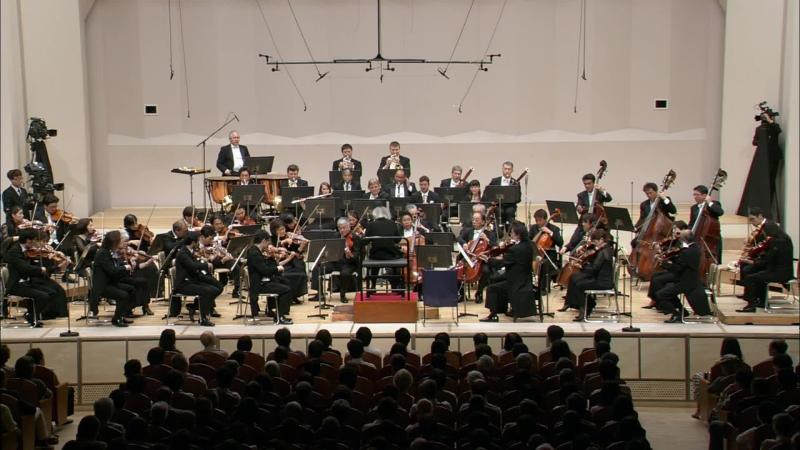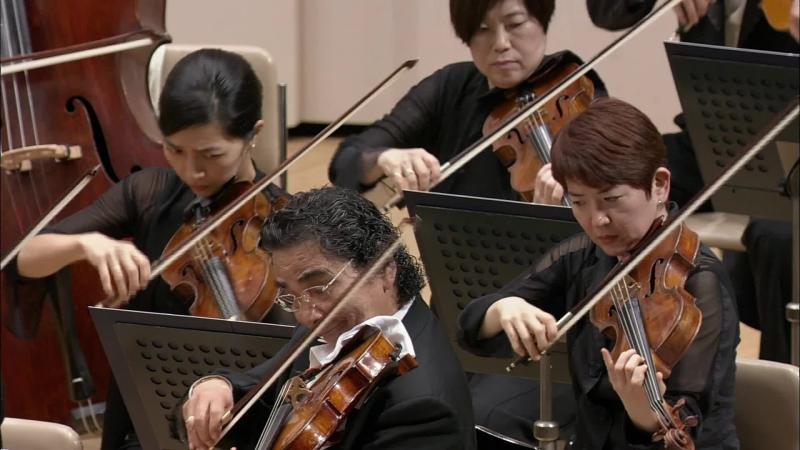

Seiji Ozawa conducts the Saito Kinen Orchestra in Beethoven Symphony No. 2 and Beethoven Symphony No. 7 at the Ozawa Matsumoto Festival. Symphony No. 2 was performed 2015 and directed for TV by Mari Inamasu. Symphony No. 7 was performed 2016 and directed for TV by Yo Asari. The Beethoven Choral Fantasy is a bonus extra with the Saito Kinen Orchestra, the Matsumoto Festival Chorus, Martha Argerich (piano), Lydia Teuscher and Rie Miyake (sopranos), Nathalie Stutzmann (alto), Kei Fukui and Jean-Paul Fouchécourt (tenors), and Matthias Goerne (baritone). Only the 2 symphonies are reviewed here. Released in 2017, disc has 5.1 dts-HD Master Audio sound. Blended grade: B+
Readers of this website know about our relentless battle against the dread disease DVDitis. We were in part inspired to combat DVDitis by a series of wonderful symphony concerts recorded around 2008 mostly by Ozawa and the Saito Kinen Ochestra. These recordings were engineered by NHK (the Japanese National Broadcasting Company), and they demonstrate the high quality that can be achieved by shooting a symphony orchestra in a manner that takes full advantage of HD cameras.
Unfortunately, the recording industry did not follow the example set by Ozawa and NHK. Instead the industry continued to shoot symphony recordings as DVD titles. Then the DVD recordings were republished in Blu-ray format as an extra profit center. This practice was understandable, because at that time there were more customers for DVD than for Blu-ray discs. But now we have several hundred Blu-ray discs published in recent years by many recording firms that are obsolete and dead-on-arrival from DVDitis.
So as far as symphony recordings are concerned, we are now (September 2017) starting from scratch with little (other than the NHK recordings mentioned above) to be proud of. We take hope, however, from the fact that the market is finally shifting away from DVD to 2K and 4K HD displays. When this shift is recognized, the recording companies will start making (we hope and predict) modern symphony recordings.
Now back to the recordings on the subject disc. Were these recordings made from the beginning to take advantage of HD video? Or are they just more victims of DVDitis? Alas, we see that they are not as good as the NHK demo discs we admire so much. But they are steps in the right direction.
Symphony No. 2
Let's look first at Symphony No. 2 recorded in 2015. I'm not going fire my full Gatling gun of statistics today---for all the details, please consult my Symphony No. 2 Wonk Worksheet. For more background information on DVDitis, see our special article describing the dread disease. My opening screenshot is of my favorite musician of all time, the Saito Kinen blind first violinist, who is being helped up on the riser by a colleague. (If you know this gentleman's name, please let me know.)
The good HDVD of a symphony concert will have plenty of large-scale shots of the entire orchestra. Next below is a head-on shot that's pretty good. But the angle is a bit low and a couple of players are not shown on the left:
The next angle below is impressive. Everybody is on board, and you can see quite well where the different sections of the band are located. On the right are 8 violas, 6 cellos, and 3 basses. All the violins are massed on the left front, and it's pretty easy to spot all the winds. Believe it or not, in many DVD-style videos we have reviewed you will not find a single clip of this fine quality:
Part-orchestra shots like the next image below help us see better the various large sections:
And next below is one of many multi-section views. All told, there are 50 large-scale shots in this 34 minute recording, which is a goodly number that distinguishes this recording from the vast majority of Blu-ray symphony discs published so far:
There are also 82 clips of smaller forces. My favorite of these would be the four violas seen next below.
And most the soloists get at least one or two clips:
So far so good. But there is one significant problem with this recording---too much emphasis on the conductor. I love Ozawa for his brilliance and his humanity. But I don't need to see, in one short symphony, 49 clips of him like the one next below:
And I really object to the 15 conductor-over-backs shots that show up in this record:
We have determined that the video content of a Blu-ray symphony recording should be judged as follows:
A good HDVD should have a slow pace with more than 10 seconds per video clip on average (longer the better). 20 to 40% (higher is better) of the clips should be large-scale "supershots" (whole-orchestra, part-orchestra, multiple-section, and large-section shots). Conductor shots should be less than 20% (way less really) of the clips in the video.
The Wonk Worksheets reveals that this Symphony No. 2 recording passes the "pace test" because the average video clip is more than 10 seconds long. 50 of the total of 198 clips are large-scale, so the "supershot" test is passed. But 32% of the clips are focused on Ozawa personally, which is way more than the 20% maximum in our test. To make matter worse, many of the Ozawa clips are extremely long. I ran the numbers on this for the 1st Movement, which lasts 774 seconds. I count 443 seconds devoted to Ozawa, which is insanely out of line with the standards set earlier by NHK and Ozawa in their benchmark recordings. Seiji is great, but I don't consider him a god---please don't let him get in the way of my enjoyment of the orchestra.
Now to a grade. We start with A+. This recording didn't use 96kHz/24-bit sound sampling, so I deduct to A (even the sound recording is excellent otherwise). The video resolution is distinctly soft, which is mysterious for a recording made in this hall in 2015. That's not acceptable and brings the grade down to B+. Since this recording badly flunks the conductor test for video content, the grade drops to C+. I compared this recording to a Blu-ray of Beethoven Symphony No. 2 made by the Vienna Philharmonic under Thielemann. The Germans use a big orchestra to imbue Symphony No. 2 with power and majesty that maybe overloads the piece. With the Saito Kinen band, I hear transparency, grace, poetry, and charm. I think this comes in part from the smaller forces used and from excellent microphone placement and mixing by the audio engineers. So I move the grade up to B-. The grade would have been a lot better if the folks making this recording had followed the lessons taught by NHK earlier.
Symphony No. 7
The recording of Symphony No. 7 was made a year later in 2016. The PQ is much improved over the previous year. The sound quality is also improved---I can hear so many of the different instruments playing at the same time even thought the orchestra is bigger than before. From the Wonk Worksheet for Symphony No. 7, you can see there are still too many conductor shots, but they tend to be shorter than in the previous year.
I'll start off a few screenshots with the another of the blind gentleman. I don't know how he does it:
Next are two fine whole-orchestra shots:
And an excellent part-orchestra angle:
Lastly, a fine multi-section shot:
But there are still 15 lazy, low-value conductor-over-backs shots:
If you want to see all the details, go back to the Beethoven Symphony No. 7 Wonk Worksheet. This video passes all the tests explained above except the conductor criterion. So now let's figure a grade. Start with an A (no 96kHz/24-bit sampling). Drop the grade to B for flunking the conductor test. But for an exceptionally charming performance and excellent work by the sound engineers, I'll move the grade to an A-. I think this will be the first time any Western recording company has earned an A grade on this website for a symphony recording. But it could easily have been better if the editors had given me more Saito Kinen and less Ozawa. (Although this Symphony No. 7 gets a good grade, it's not quite good enough to put on my list of the best classical symphony recordings.)
I would give this disc an overall blended grade of B+. This is heading in the right direction from the D+ to C+ grades we have given to many of the DVDitis-infected Blu-ray symphony titles we have reviewed in recent years.
Here below is the official Euroarts YouTube clip. It's quite pretty with its many whole-orchestra and part-orchestra views of the Saito Kinen Orchestra in action:
OR















